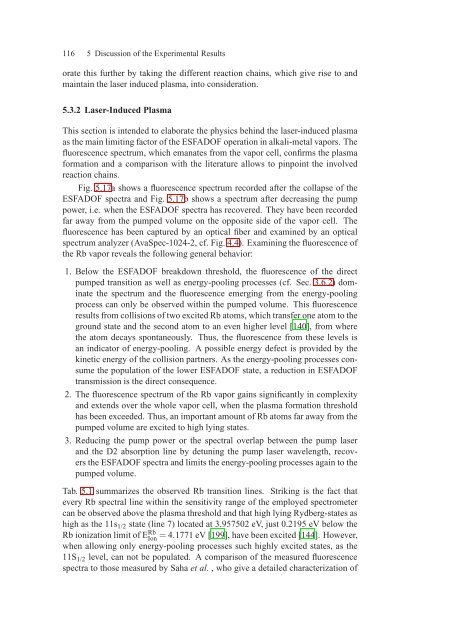Assessment of a Rubidium ESFADOF Edge-Filter as ... - tuprints
Assessment of a Rubidium ESFADOF Edge-Filter as ... - tuprints
Assessment of a Rubidium ESFADOF Edge-Filter as ... - tuprints
You also want an ePaper? Increase the reach of your titles
YUMPU automatically turns print PDFs into web optimized ePapers that Google loves.
116 5 Discussion <strong>of</strong> the Experimental Results<br />
orate this further by taking the different reaction chains, which give rise to and<br />
maintain the l<strong>as</strong>er induced pl<strong>as</strong>ma, into consideration.<br />
5.3.2 L<strong>as</strong>er-Induced Pl<strong>as</strong>ma<br />
This section is intended to elaborate the physics behind the l<strong>as</strong>er-induced pl<strong>as</strong>ma<br />
<strong>as</strong> the main limiting factor <strong>of</strong> the <strong>ESFADOF</strong> operation in alkali-metal vapors. The<br />
fluorescence spectrum, which emanates from the vapor cell, confirms the pl<strong>as</strong>ma<br />
formation and a comparison with the literature allows to pinpoint the involved<br />
reaction chains.<br />
Fig. 5.17a shows a fluorescence spectrum recorded after the collapse <strong>of</strong> the<br />
<strong>ESFADOF</strong> spectra and Fig. 5.17b shows a spectrum after decre<strong>as</strong>ing the pump<br />
power, i.e. when the <strong>ESFADOF</strong> spectra h<strong>as</strong> recovered. They have been recorded<br />
far away from the pumped volume on the opposite side <strong>of</strong> the vapor cell. The<br />
fluorescence h<strong>as</strong> been captured by an optical fiber and examined by an optical<br />
spectrum analyzer (AvaSpec-1024-2, cf. Fig. 4.4). Examining the fluorescence <strong>of</strong><br />
the Rb vapor reveals the following general behavior:<br />
1. Below the <strong>ESFADOF</strong> breakdown threshold, the fluorescence <strong>of</strong> the direct<br />
pumped transition <strong>as</strong> well <strong>as</strong> energy-pooling processes (cf. Sec. 3.6.2) dominate<br />
the spectrum and the fluorescence emerging from the energy-pooling<br />
process can only be observed within the pumped volume. This fluorescence<br />
results from collisions <strong>of</strong> two excited Rb atoms, which transfer one atom to the<br />
ground state and the second atom to an even higher level [140], from where<br />
the atom decays spontaneously. Thus, the fluorescence from these levels is<br />
an indicator <strong>of</strong> energy-pooling. A possible energy defect is provided by the<br />
kinetic energy <strong>of</strong> the collision partners. As the energy-pooling processes consume<br />
the population <strong>of</strong> the lower <strong>ESFADOF</strong> state, a reduction in <strong>ESFADOF</strong><br />
transmission is the direct consequence.<br />
2. The fluorescence spectrum <strong>of</strong> the Rb vapor gains significantly in complexity<br />
and extends over the whole vapor cell, when the pl<strong>as</strong>ma formation threshold<br />
h<strong>as</strong> been exceeded. Thus, an important amount <strong>of</strong> Rb atoms far away from the<br />
pumped volume are excited to high lying states.<br />
3. Reducing the pump power or the spectral overlap between the pump l<strong>as</strong>er<br />
and the D2 absorption line by detuning the pump l<strong>as</strong>er wavelength, recovers<br />
the <strong>ESFADOF</strong> spectra and limits the energy-pooling processes again to the<br />
pumped volume.<br />
Tab. 5.1 summarizes the observed Rb transition lines. Striking is the fact that<br />
every Rb spectral line within the sensitivity range <strong>of</strong> the employed spectrometer<br />
can be observed above the pl<strong>as</strong>ma threshold and that high lying Rydberg-states <strong>as</strong><br />
high <strong>as</strong> the 11s 1/2 state (line 7) located at 3.957502 eV, just 0.2195 eV below the<br />
Rb ionization limit <strong>of</strong> E Rb<br />
Ion = 4.1771 eV [199], have been excited [144]. However,<br />
when allowing only energy-pooling processes such highly excited states, <strong>as</strong> the<br />
11S 1/2 level, can not be populated. A comparison <strong>of</strong> the me<strong>as</strong>ured fluorescence<br />
spectra to those me<strong>as</strong>ured by Saha et al. , who give a detailed characterization <strong>of</strong>
















